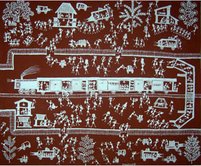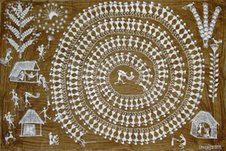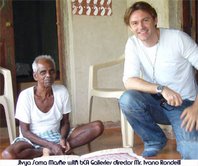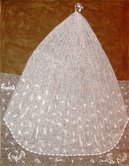Contribute
| South Asian Art - In Memory Of Prashant H. Fadia |
Razvin Namadarian
02/26/2009
A Tête-à -Tête with Jivya Soma Mashe – Legendary Warli Artist
India is regarded in the West as a land of mystics, religion and of course – computer geeks! Very few know that almost every state of India is home to indigenous tribes, which may slowly be adopting modern ways but have retained their strong tribal identity. One such tribe is the Warlis of Maharashtra state. Of these one of them in particular has gained national and international fame - Jivya Soma Mashe, is a living legend. He has taken a tribal art form – Warli Art into the annals of international art history. His paintings grace the walls of museums worldwide.
I met Jivya Soma Mashe on a hot and humid afternoon of November at his house about 150 Kms from Mumbai, often termed India’s financial capital. His house is the only brick house of the village and the road to his house is the only paved road of the whole village.. The rooms are simply, if not barely, furnished. We sit on the veranda facing a line of cactus, which separate the front lawn from the fields behind. Mr. Mashe is wearing a shirt and shorts and in this heat I cannot but envy him. As we start the interview he lights up a bidi, a traditional Indian cigarette, and smiling he tells me “I should stop smoking at my ageâ€. We both know he does not really mean it.
Who are the Warlis?
We, the Warlis are a simple people. While earlier we were mainly subsisting as hunters, over the generations we have settled down to agricultural life. Despite the fact that our village is so close to a metropolis like Mumbai we have retained our own unique culture and heritage. Some of the youngsters get restless and move to the big city but most of us are happy to be in these pristine surroundings. At the same time we do not abhor technology and development, evolution is a way of life, but we must learn to retain the good and reject the bad. For us owning a tractor to work our lands is one of the greatest boons that the modern ways have brought.
What is Warli art?
The Warlis were limited in their ways of expression as we have no written script. The tales and legends were passed down by rote through the generations. Yet I felt that we yearned to be able to express ourselves in some form other than verbally. Thus was born the Warli art. We use our simple forms and drawings to portray and depict our complex concepts of folklore, festivals, traditions and heritage. Initially these drawings were made on the walls of our homes especially during religious ceremonies or festivals. These drawings were made only by the women and they only used a fixed set of motifs, the ‘chauk’, the Earth Goddess and such. I was the first male who started painting Warli, I introduced new motifs and I follow my heart not some set rules of drawing. My sons have also taken to this art, in a sense you could say that I helped to lead male liberation in pursuit of the arts amongst the Warlis. Now we use paper and cloth which has been coated with cow dung or a rich red coloured natural derivative we call ‘gheru’, our paint is rice paste mixed with gum resin, our brush, a small twig – we believe in simple living, high thinking. The Warli art speaks of our way of life, our culture; it reveals the heart of the Warlis.
How did you first come to discover your own artistic talent?
My initiation into art has a very sad history behind it. When I was very little my mother passed away and my stepmother was not very kind. I was in such shock that for several years I could not speak. These drawings and paintings were the only way I could convey my thoughts and desires to those around me, they were my voice and my sanctuary during my troubled childhood. I was fortunate that others of my village noticed my talent and began to encourage me. The ladies would even call me their homes during the times of special ceremonies, like weddings or festivals like the harvest and Diwali (festival of lights) festivals to decorate their homes by painting on their walls. I am lucky that they took me with them to Delhi when the government was promoting tribal art and got me into the limelight.
Of all the accolades you have received which is most memorable?
Well I have been felicitated many times both in India and abroad, they were all very heartening reminders that there are people out there who appreciate and listen to what a simple man like me it trying to say. However, I have to say the National Award that was presented to me in 1976 is still very close to my heart. It was one of the first honours given to me in my own country. Besides Mrs. Indira Gandhi, the then Prime Minister of India (who many compared with the Iron Lady Margaret Thatcher of the United Kingdom) handed me the award and I have always had immense admiration for the poise and dignity with which she executed her office.
You have been invited to many foreign lands, which trip stands out?
I have been lucky that many foreigners like my work and have invited me to stay amongst them and show them how I create my art. I have been to places like Canada, Japan, Germany and Italy; there are those in my village who have only seen a plane up high in the sky. I am quite a celebrity in my village mainly also because I have actually flown like a bird from one country to another. My last trip was to Italy, I was taken by bCA Galleries who had organised my solo exhibition in Milan. I was humbled by the high esteem in which they regard my work and the warmth and kindness I was shown there.
What future do you foresee for Warli or other tribal arts?
Today I see many trying to copy the Warli tribal art. There are advertisements in newspapers which claim that they can teach Warli art in a few days. I wonder how they proclaim this. Warli is a way of life. If you have not lived it, how can you speak of it, for our paintings are nothing but an ongoing conversation. No one can teach you to paint Warli, yes they can teach you our style of trees, our community spiral but can they teach you the stories woven into the fabric of our art, can they reveal the toil at harvest time or while toddy tapping, can they portray the joy at weddings or festivals? Never! Only a true Warli can give you Warli art. I am sure the same applies to all the other tribal art forms. I would love to see our government doing more to help the villagers and tribals flourish with their own indigenous art. When more of us get our just dues and recognition then out youngsters will not be so keen to blindly ape the new ways and our legacy will continue.
On that note as we leave him, he is putting the finishing touches on his latest art work, a giant spider web suspended between two trees. One can’t but wonder at the way in which nature is so intricately woven into the web of Jivya Mashe’s life, nurturing his quite genius and giving us a glimpse of the glory in the simple ways of the Warlis.
You may also access this article through our web-site http://www.lokvani.com/




